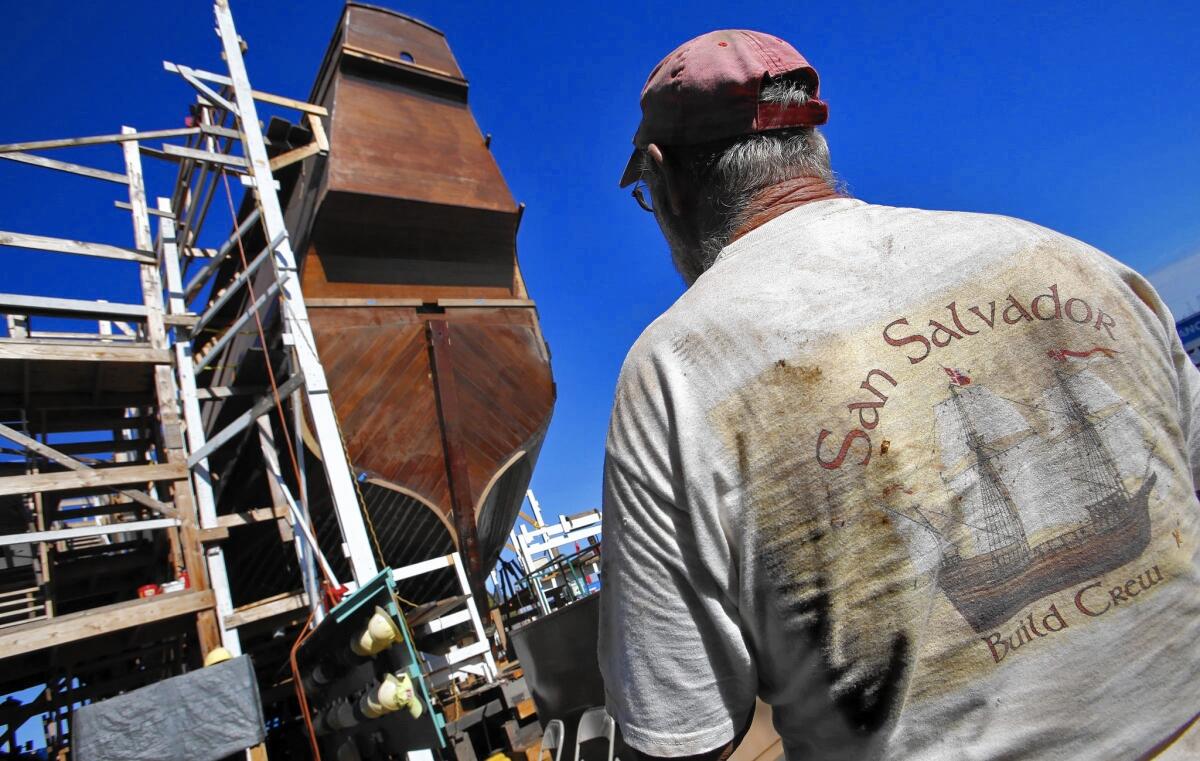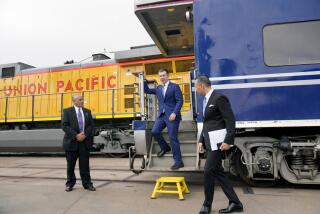San Diego museum to unveil replica of explorer Juan Rodriguez Cabrillo’s ship

When explorer Juan Rodriguez Cabrillo and his flagship San Salvador pulled into San Diego Bay on Sept. 28, 1542, he was not just trying to impress the locals with the grace of his three-masted galleon.
He was on a business trip, in hopes of opening up the West Coast of America for Europeans.
And so it is fitting that the full-size replica of Cabrillo’s flagship, which took more than $6.2 million and four years to build, has a business-style goal when it makes its long-awaited public debut Friday afternoon.
At 150 tons, measuring 92 feet in length, 24 feet in width, lovingly constructed with wood from Suriname, Nigeria, the Pacific Northwest and Georgia, the San Salvador is set to lead the parade of tall ships, the traditional opening of the annual three-day Festival of Sail.
Officials at the Maritime Museum of San Diego, which sponsored the replica project, hope the fully functional San Salvador, once it takes its place among the museum’s other historic ships along the Embarcadero, will “transform” the area into a nautical theme park.
While San Diego, with its zoo, beaches and (at least for the moment) NFL team, does not lack for tourists, museum officials envision the San Salvador adding to the city’s allure as one of the spots where modern America began.
Mark Montijo, the Maritime Museum’s vice president and chief administrative officer, likes to point out that Cabrillo landed in San Diego Bay 78 years before the Mayflower arrived at Plymouth Rock.
San Diego has long laid claim to the legacy of Cabrillo, considered by historians as the first European to set foot in California. A 13-foot-tall statue of the explorer adorns the Cabrillo National Monument at the tip of the Point Loma peninsula; a festival each year reenacts Cabrillo’s wading ashore at Ballast Point.
Cabrillo is in the “DNA of San Diego,” Port Commission Chairman Dan Malcolm told a gathering when the San Salvador replica was moved by barge from Spanish Landing near Lindbergh Field to a boatyard in Chula Vista, from which it will launch to lead the parade.
Founded in 1948, the Maritime Museum draws about 150,000 visitors a year to its collection, which includes its flagship the Star of India (built in 1863, billed as the world’s oldest working ship), a Soviet submarine, the schooner Californian, the replica frigate HMS Surprise, the steam ferryboat Berkeley and more.
Just down the block, the carrier museum Midway, operated by a separate nonprofit group, gets more than 1 million visitors annually. In a decade it has become the nation’s most popular naval warship museum.
Maritime Museum officials would like to narrow the attendance gap and shake off what the local press, normally quite supportive of local tourist attractions, calls its “musty image.” For the first time, this year’s parade will be live-streamed on Periscope, Meerkat and YouTube, definitely a nonmusty move.
Throughout the U.S., there is a trend toward “heritage tourism” that stresses the history of a location. But a report done by the San Diego Regional Economic Development Corp. about how the city can capitalize on that trend notes, “tourism is a competitive and fast-pace industry.”
Carl Winston, head of the L. Robert Payne School of Hospitality and Tourism at San Diego State, rates himself as impressed by the boldness of the San Salvador project. Even mega-sites such as the San Diego Zoo and SeaWorld, Winston said, know that “you need to add new bells and whistles” to keep attracting visitors.
“These guys are hustlers,” Winston said of the Maritime Museum. “”This is going to be a great addition to tourism in San Diego, a very cool thing.”
For the parade, the San Salvador will be powered by an auxiliary engine. Its sails have yet to be rigged. That will come in the next few months as the finishing touches are applied.
Thousands of spectators are expected to line the shoreline along Point Loma, Harbor Island, Shelter Island, Coronado and the Embarcadero to glimpse the San Salvador and the other ships when the parade begins at 3 p.m. Among the activities planned during the festival: a simulated cannon battle at sea.
Despite significant public interest, the San Salvador project has not known smooth sailing.
A plan for a “grand public launch” in April had to be scrapped. Construction, even with hundreds of skilled volunteers, has taken longer than anticipated. For one thing, no plans for the original are known to exist.
Beyond some last-minute construction, more fundraising is needed to provide about $500,000 more, Montijo said. About a third of the money so far has come from the California State Coastal Conservancy, the rest from foundations, companies, individuals and more than 500 small-scale donors.
For the parade, the Coast Guard has given the OK for a crew of 10 to be aboard the San Salvador. But it has yet to give approval to take paying passengers outside the bay. Maritime Museum officials want the ship to sail soon to ports northward, maybe to Northern California, a floating classroom encouraging the public to come to San Diego.
“It’s probably taken us longer to build the replica than it took Cabrillo to build the original,” said Montijo, only half in jest, “but Cabrillo didn’t need approval from the Coast Guard.”
More to Read
Sign up for Essential California
The most important California stories and recommendations in your inbox every morning.
You may occasionally receive promotional content from the Los Angeles Times.










